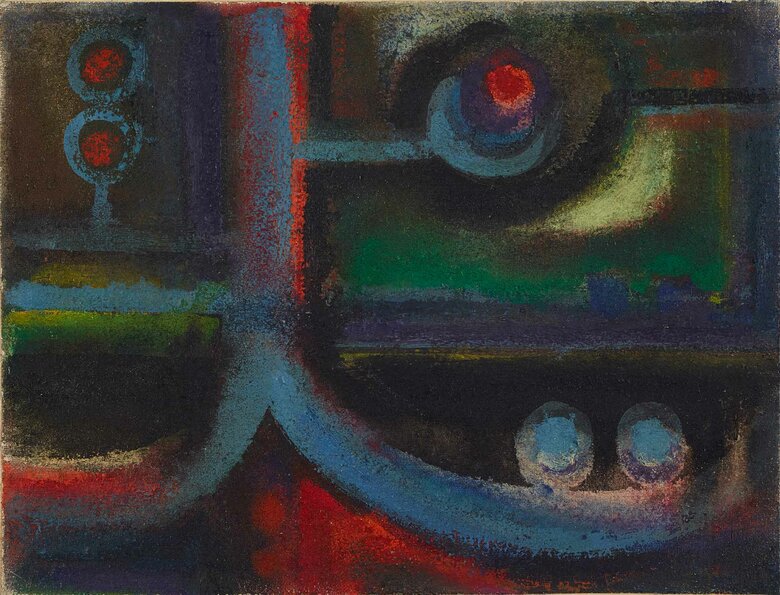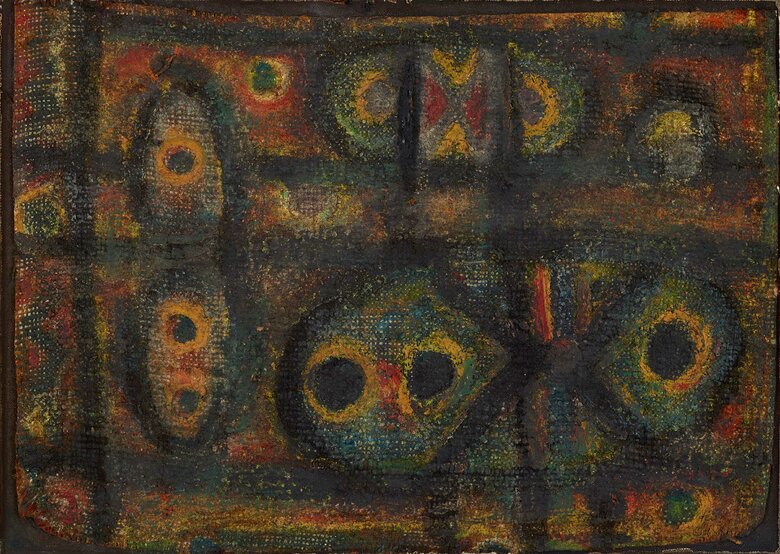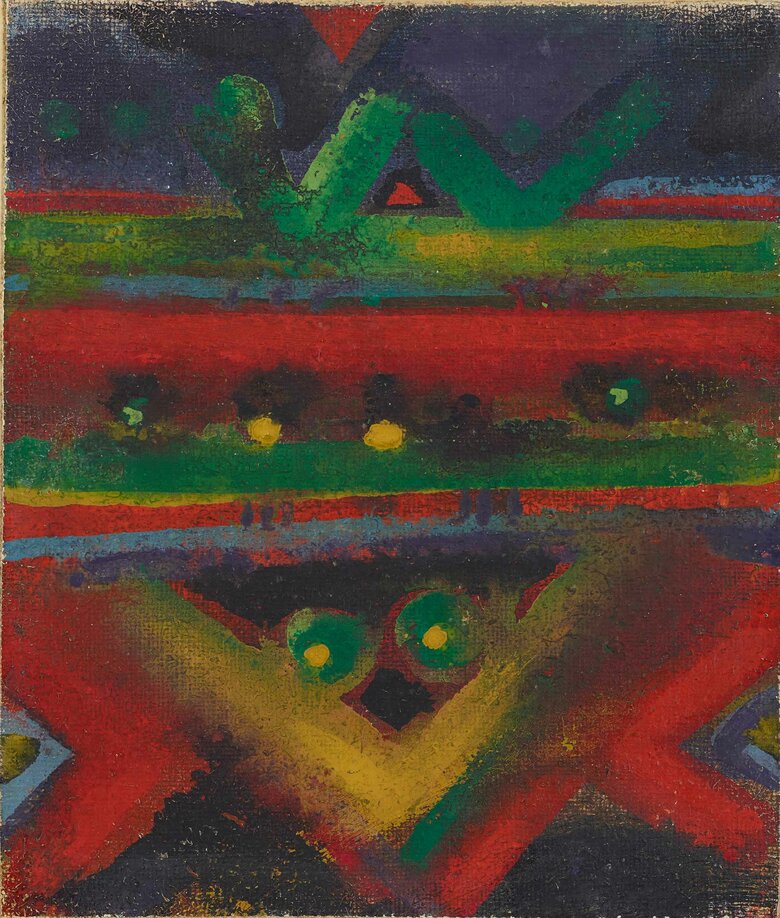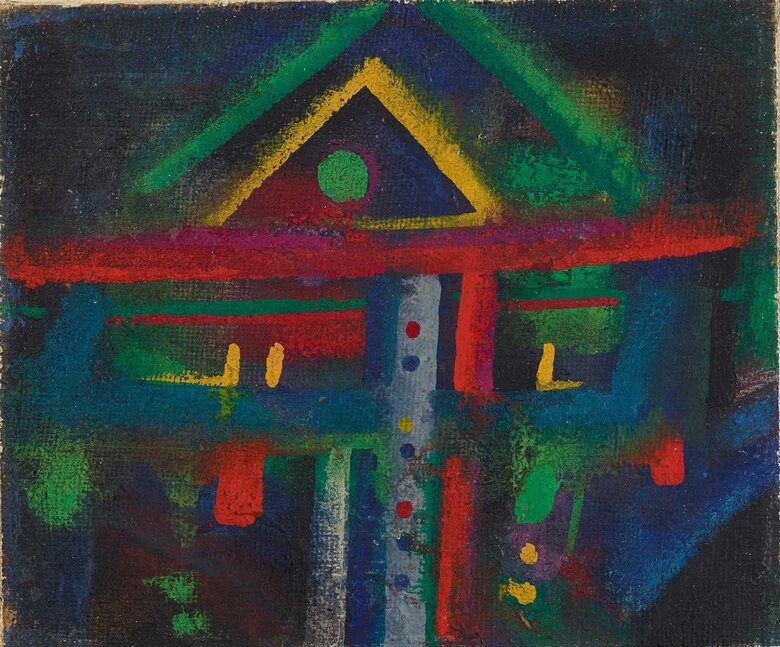Born in Boujad, east of Khouribga, Morocco, Ahmed Cherkaoui was a descendant of the Sufi brotherhood named Charqawiyya. Indeed, he enrolled at the local Koranic school, where he studied Qur’an,...
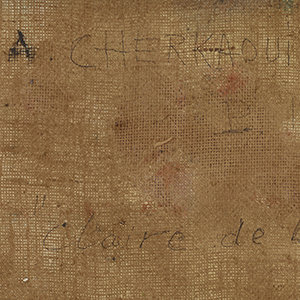

AHMED CHERKAOUI, Morocco (1934 - 1967)
Bio
Written by ARTHUR DEBSI
Born in Boujad, east of Khouribga, Morocco, Ahmed Cherkaoui was a descendant of the Sufi brotherhood named Charqawiyya. Indeed, he enrolled at the local Koranic school, where he studied Qur’an, and developed a passion for calligraphy. Then, he relocated to Casablanca, to continue his education, but the urban environment didn’t satisfy him. He was also deeply affected by the passing of his mother, which occurred around the same time. When Morocco got its independence from France in 1956, Ahmed Cherkoui traveled to Paris, where he studied graphic arts at the École des Métiers d’Art, until 1959. At the same time, he lived the vibrant artistic environment of the French capital city, and was exposed to the works of modern artists such as Paul Klee (1879-1940), and Roger Bissière (1886-1964). During his time he settled in the famous Latin Quarter in Paris. Cherkaoui mixed with members of the Moroccan community, including the architect Mourad Ben Embarek (d.2011), the writer Abdelkebir Khatibi (1938-2009), and some artists like Farid Belkahia (1934-2014). By sharing ideas, and advancing theories, all of these figures of the diaspora played a key role in the construction of the national, and cultural identity of Morocco. Soon after his graduation from the École des Métiers d’Art, Cherkaoui got his first job in the French musical company Pathé-Marconi, where he drew the covers models of discs from the Oriental music department.
In 1960, Ahmed Cherkaoui entered the École Nationale Supérieure des Beaux-Arts in Paris, attending courses at the atelier of the French artist Jean Aujame (1905-1965). On year later, he benefited from a one-year scholarship, as part of a cultural exchange between Morocco, and Poland, which enabled him to pursue his education at the Academy of Fine Arts in Warsaw, Poland. There, he intensively trained under the supervision of the Polish abstract artist Henryk Stazewski (1894-1988). He also experienced the artistic dynamic of the city, which was different from the one in Paris. Back to France in summer 1961, Ahmed Cherkaoui encountered the art critic Jean-Clarence Lambert (1930-), with whom he was able to participate in the second edition of the Biennale des Jeunes Artistes at the Musée d’Art Moderne de la Ville de Paris. In March 1962, Cherkaoui had his first solo-exhibition at the gallery of Ursula Girardon, and participated in the exhibition ‘École de Paris’, alongside with his contemporaries Mohamed Melehi (1936-2020), and Jilali Gharbaoui (1930-1971), at the gallery Charpentier in October 1962. Going back and forth between Paris, and Morocco, the painter rapidly imposed himself in the Parisian art scene during the 1960s.
In 1965, Ahmed Cherkaoui was appointed as a drawing teacher in a college in Beaumont-sur-Oise, in the North of Paris. However, he felt the need to leave the France after the Six-Days war in 1967, when Israel attacked Egypt, and annexed some territories like East-Jerusalem, and the Golan Heights. At that time, Cherkaoui realized that artists, and intellectuals supported Israel’s actions against Arab countries; and consequently, decided to go back to Morocco[1]. Abandoning his desire for fame, he preferred to contribute to the development of his home country, through the teaching of the young generation. There, he started a new job as an advertising designer, and could reconnect to his roots.
Ahmed Cherkaoui was very enthusiastic to see Morocco breaking away from the French influence in the 1960s. He always thought that Moroccan people could equally enjoy modern art, which is not a Western monopoly. He even hated the idea of calling a painter ‘Moroccan’, since he considered the word ‘painter’ to be universal[2].
In Europe, Ahmed Cherkaoui discovered the avant-garde art movements, which had developed since the beginning of the 20th century, and progressively familiarized himself with abstraction. And in 1961, the artworks, that he exhibited at the Krzywe-Koło gallery in Warsaw, confirmed that he completely adopted the abstract movement[3]. During a short stay in Morocco in summer 1962, the painter delved into the Moroccan artistic heritage; which led him to conduct extensive research on the local folk-art. The Moroccan writer Edmond Amran el-Maleh remembered: ‘Ahmed Cherkaoui se consacre à étudier les formes, le graphisme des tatouages, des dessins sur les poteries et d’autres objets’[4]. It has even been reported that he was the first artist to conduct in-depth research on the sign, by travelling all around the country, and analyzing Moroccan craftsmanship including rugs, pottery, and jewelry[5]. It was important for Cherkoui to build a singular style, which would correspond to Morocco’s cultural mosaic. Like this latter mosaic, he found inspiration from his family background: from the paternal side, the artist belonged to the Sufi community, whereas on the maternal side, he came from the Berber tribe called Zayanes, known for its art of carpet-making[6].
As of the 1960s, Ahmed Cherkaoui showed an insatiable interest, and fascination for the sign, which is inherent to the artistic tradition in the pre-Islamic, Islamic, and Berber societies. He consequently considered himself to be affiliated to this millennial practice. A series of paintings demonstrate the seminal work of the artist, based on the local heritage. In the example Miroirs (1963), Ahmed Cherkaoui used burlap as a material, that he tapered, colored, and stuck on the panel. Inspired by Paul Klee (1879-1940), Cherkaoui often exploited this peculiar technique, which gave his works a textured aspect. Here, he applied with thick brushstrokes, a palette of warm, and brilliant colors, such as red, yellow, green, which recall the colors of Morocco’s landscapes. In parallel, Cherkaoui combined dots with geometrical shapes, like the triangle, and the half circle. These elements form signs, which highly resemble the henna tattoos, that the Berber men, and women have on their faces, and hands. The Berber tattoos mainly have an aesthetic function, but can also indicate the social status of a person[7]. Visiting the Berber people in the Atlas Mountains, Ahmed Cherkaoui thoroughly observed these graphic tattoos, which illustrate plants, stars, animals, etc. Yet, he reinterpreted the motifs in his artworks, by intertwining them with each other, and without giving them a specific meaning. The sign becomes an experimental element of plastic research.
Having chosen to work on abstraction, Ahmed Cherkaoui however never neglected the spiritual dimension, that his paintings had to convey. The Berber tattoos are related to magic, and pagan rituals; but the artist also took inspiration from Sufi movement, to which he was historically affiliated. The hometown of Cherkaoui, Boujad, is famous for having hosted the Sufi brotherhood of Sheikh Sidi Muhammad bin al-Arabi bin al-Ma’ti bin al-Salih al-Sharqawi (d.1601). In the 17th century, the Charqawiyya brotherhood provided the first Alawite sultan of Morocco, Moulay Rashid (1666-1672), an important political support in his fight against another Sufi brotherhood, the Zaouia of Dila. Affiliated to this community, Ahmed Cherkaoui always stayed attached to the Oriental spirituality, which influenced the stages of his artistic journey. The painter mastered the art of Arabic calligraphy – a fundamental art practice in Sufism –, but didn’t aim to produce scripts, with proper letters. Cherakoui was effectively more interested in the gesture itself, and the shapes of the line, el-khatt, which can create sensations. In another piece entitled Clair de Lune (1963), Cherkaoui used curved, and straight thick lines, that he traced in a confident, and assertive gesture. The painting dated from the short period, between 1963-1964, when the artist produced artworks, only employing a dark background, contrasting with pure colors. Here, he colored the motifs with a bright red, which gives the ensemble a remarkable luminosity, enhancing the depth of the composition. Ahmed Cherkaoui readapted the essence of calligraphy, which is originally a sacred activity, through a modern technique, to render mystical strength in another way.
Ahmed Cherkaoui sought for an artistic expression, which resulted from his own visual memory, when he was young. Nourished by this personal richness, he realized that the elaboration of modern Moroccan art had to reveal the uniqueness Moroccan identity. This identity includes a rich combination of cultures, and traditions, which had persisted through centuries in the country. During his short-time career, Cherkaoui chose to reinterpret the local heritage in a modern plastic treatment. This approach corresponded to the time, when Morocco was a young nation, which had to understand its past in order to hook itself to the modernity train of the 20th century.
Ahmed Cherkoui prematurely passed away in 1967 in Casablanca.
Notes
[1] ‘Melehi raconte Cherakoui’. Testimony reported by Kenza Sefrioui in Alaoui, Brahim, Bruno Nassim Aboudrar, Hélène Le Corre, Toni Maraini, Meryem Sebti, and Kenza Sefrioui. ‘Cinquante Ans Après, Redécouvrir Cherkaoui’, 2018. https://brahimalaoui.files.wordpress.com/2018/07/diptyk43_dossier_ahmed_cherkaoui-2.pdf. [P.82]
[2] ‘Melehi raconte Cherakoui’. Testimony reported by Kenza Sefrioui in Alaoui, Brahim, Bruno Nassim Aboudrar, Hélène Le Corre, Toni Maraini, Meryem Sebti, and Kenza Sefrioui. ‘Cinquante Ans Après, Redécouvrir Cherkaoui’, 2018. https://brahimalaoui.files.wordpress.com/2018/07/diptyk43_dossier_ahmed_cherkaoui-2.pdf. [P.82]
[3] Alaoui, Brahim, Bruno Nassim Aboudrar, Hélène Le Corre, Toni Maraini, Meryem Sebti, and Kenza Sefrioui. ‘Cinquante Ans Après, Redécouvrir Cherkaoui’, 2018. https://brahimalaoui.files.wordpress.com/2018/07/diptyk43_dossier_ahmed_cherkaoui-2.pdf. [P.76]
[4] ‘Ahmed Cherkaoui dedicated himself to study the forms, the design of the tattoos, the design employed on pottery, and other objects. Edmond Amran el-Maleh quoted in Alaoui, Brahim, Bruno Nassim Aboudrar, Hélène Le Corre, Toni Maraini, Meryem Sebti, and Kenza Sefrioui. ‘Cinquante Ans Après, Redécouvrir Cherkaoui’, 2018. https://brahimalaoui.files.wordpress.com/2018/07/diptyk43_dossier_ahmed_cherkaoui-2.pdf. [P.76]
[5] Ali, Wijdan. Modern Islamic Art: Development and Continuity. Gainesville, USA: University Press of Florida, 1997. [P.75]
[6] Alaoui, Brahim. ‘Déchiffrer la mémoire’ in ‘Ahmed Cherkaoui dedicated himself to study the forms, the design of the tattoos, the design employed on pottery, and other objects. Edmond Amran el-Maleh quoted in Alaoui, Brahim, Bruno Nassim Aboudrar, Hélène Le Corre, Toni Maraini, Meryem Sebti, and Kenza Sefrioui. ‘Cinquante Ans Après, Redécouvrir Cherkaoui’, 2018. https://brahimalaoui.files.wordpress.com/2018/07/diptyk43_dossier_ahmed_cherkaoui-2.pdf. [P.75]
[7] Lebkiri, M. (2018). Le rite : Les tatouages berbères. Retrieved February 09, 2021, from https://www.arte.tv/fr/videos/085509-000-A/le-rite-les-tatouages-berberes/
Sources
Alaoui, Brahim, Bruno Nassim Aboudrar, Hélène Le Corre, Toni Maraini, Meryem Sebti, and Kenza Sefrioui. ‘Cinquante Ans Après, Redécouvrir Cherkaoui’, 2018. https://brahimalaoui.files.wordpress.com/2018/07/diptyk43_dossier_ahmed_cherkaoui-2.pdf.
Ali, Wijdan. Modern Islamic Art: Development and Continuity. Gainesville, USA: University Press of Florida, 1997.
Aroussi, Moulim el. Les Tendances De La Peinture Contemporaine Marocaine. Casablanca, Morocco: PM Editions, 2002.
Aroussi, Moulim el., and Brahim Alaoui. Peinture Marocaine 1950-2010: Collection Elisabeth Bauchet-Bouhlal. Marrakech, Morocco: ES-SAADI Garden & Resort, 2010.
Eigner, Saeb. Art of the Middle-East, Modern and Contemporary Art of the Arab World and Iran. London, UK: Merell Publishers Limited, 2011.
Goldenberg, André. “1956 - 1986 : Trente Ans De Peinture Marocaine.” Cahiers De La Méditerranée, 1989.
Lebkiri, M. (2018). Le rite : Les tatouages berbères. Retrieved February 09, 2021, from https://www.arte.tv/fr/videos/085509-000-A/le-rite-les-tatouages-berberes/
Lenssen, Anneka, A. Rogers, Sarah, and Shabout, Nada. Modern Art in the Arab World, Primary Documents. New York, USA: The Museum of Modern Art, 2018.
Merzaban, Mandy. Re-Orient: Investigating Modernism in the Arab World 1950's-70's. Sharjah, UAE: Art Advisory Associates Ltd., 2013.
CV
Selected Solo Exhibitions
1962
Galerie Ursula Girardon, Paris, France
1961
Goethe Institute, Casablanca, Morocco
Krzwe-Kolo Gallery, Warsaw, Poland
1959
Atelier de l’imprimerie Lucienne Thalheimer, Paris, France
Selected Group Exhibitions
2024
Arab Presences: Modern Art And Decolonisation: Paris 1908-1988, Musée d'Art Moderne de Paris, Paris, France
2023
Casablanca Art School, Tate St. Ives, St. Ives, Cornwall, United Kingdom
2022
Taking Shape: Abstraction from the Arab World, 1950-1980s, Herbert F. Johnson Museum, Cornell University, Ithaca, United States of America
Taking Shape: Abstraction from the Arab World, 1950-1980s, Block Museum of Art of Northwestern University, Evanston, United States of America
Paris et nulle part ailleurs, Musée de l’histoire de l’immigration, Paris, France
2021
Taking Shape: Abstraction from the Arab World, 1950-1980s, Tampa Museum of Art, Tampa, United States of America
Taking Shape: Abstraction from the Arab World, 1950-1980s, McMullen Museum of Art at Boston College, Boston, United States of America
2020
Modern Masters, Meem Gallery, Dubai, United Arab Emirates
2018
A Century in Flux, Highlights from the Barjeel Art Foundation, Sharjah Art Museum, Sharjah, United Arab Emirates
2017
E-Mois, Autobiographie d’une collection, MACAAL, Marrakech, Morocco
Chefs-d’Oeuvre de l’Art Moderne et Contemporain Arabe, Institut du Monde Arabe, Paris, France
2016
The Sea Suspended, Tehran Museum of Contemporary Art, Tehran, Iran
The Short Century, Sharjah Museum, Sharjah, United Arab Emirates
2014
Sky Over the East, Emirates Palace, Abu Dhabi, United Arab Emirates
2013
Re: Orient, Barjeel Art Foundation, Sharjah, United Arab Emirates
1996
Cherkaoui ou la passion du signe, Institut du Monde Arabe, Paris, France
1995
Regards Immortels, Forum Espace Congrès du Riad Salam, Casablanca, Morocco
1991
Peintres du Maroc: Belkahia, Bellamine, Cherkaoui, Kacimi, Institut du Monde Arabe, Paris, France
1988
Peinture Contemporaine au Maroc, Musée des Beaux-Arts d’Ixelles, Brussels, Belgium
1985
19 Peintres du Maroc, Centre National d’Art Contemporain de Grenoble, Grenoble, France
1974
Les Flamboyants, Galerie l’OEil-de-Boeuf, Paris, France
La Peinture Marocaine dans les Collections Privées, Galerie Nadar, Casablanca, Morocco
1970
Le Jardin de Matisse, Festival des Arts de Châtillon, Châtillon, France
1969
Intéferences Poètes-Peintres, Galerie Daniel Templon, Paris, France
1968
Hommage à Cherkaoui, Salon de Mai, Paris, France
1967
Hommage à Cherkaoui, Salon de l’Art Sacré, Musée d’Art Moderne de la Ville de Paris, Paris, France
1966
L’Âge du Jazz, Musée Galliéra, Paris, France
Six Peintres du Maghreb, Galerie des Arts, Tunis, Tunisia
Six Peintres du Maghreb, Galerie Peintres du Monde, Paris, France
Festival International des Arts Nègres, Dakar, Senegal
1965
Art in Morocco Today, Palacio del Cristal del Retiro, Madrid, Spain
Peintres Marocains, Galerie Bab Rouah, Rabat, Morocco
1964
Exposition Internationale, Musée National des Beaux-Arts, Algiers, Algeria
Art Contemporain Français – Du Labyrinthe de la Ville à la Chambre d’Amour, Tokyo, Japan
Action et Réflexion, Galerie A, Paris, France
Tendances, Galerie Le Fleuve, Paris, France
1963
Rencontre Internationale des Artistes, Musée des Oudayas, Rabat, Morocco
Autour du Jeu, Galerie Ursula Girardon, Paris, France
The 3rd Biennale des Jeunes, Paris, France
2000 Ans d’Art au Maroc, Galerie Charpentier, Paris, France
Peintres du Maghreb, Galerie du Gouvernail, Paris, France
Salon de Mai, Paris, France
Vingt Peintres Étrangers, Musée d’Art Moderne de la Ville de Paris, Paris, France
1962
École de Paris 1962, Galerie Charpentier, Paris, France
Options, Galerie Ursula Girardon, Paris, France
Salon de Mai, Paris, France
Peintres de l’École de Paris et Peintre Marocains, Théâtre National Mohammed V, Rabat, Morocco
1961
Salon d’Automne, École des Beaux-Arts in Casablanca, Casablanca, Morocco
The 2nd Biennale des Jeunes, Paris, France
1960
Salon de la Jeune Peinture, Rabat, Morocco
Honors and Awards
1962
2nd Place in the Prix Manguin
Bronze Medal at the 10th Salon Interministériel de Paris
Collections
Mathaf: Arab Museum of Modern Art, Doha, Qatar
Musée d’Art Moderne de la Ville de Paris, Paris, France
Musée Mohammed VI d’Art Moderne et Contemporain, Rabat, Morocco
Institut du Monde Arabe, Paris, France
The Barjeel Art Foundation, Sharjah, United Arab Emirates
The Ramzi and Saeda Dalloul Art Foundation, Beirut, Lebanon
Press
طباعة - أعمال أحمد الشرقاوي_ سَفرٌ من الدوحة إلى الرباط.pdf
Alquds Newspaper.pdf
الحياة - «تشكيل» لأحمد الشرقاوي_ التجريد الآتي من الحياة اليومية.pdf
تخليدا لذكرى الفنان احمد الشرقاوي _ الملتقى الدولي الثاني للفنون التشكيلية بابي الجعد المجلة الفنية.pdf
ART MOROCCO_ Mohammed Melehi Ahmed Cherkaoui and Jilali Gharbaoui - Magazine Islamic Arts Magazine.pdf
Regard sémiotique sur la peinture intemporelle de Ahmed Cherkaoui Mustapha Saha.pdf
Le Matin - L’ambassade de Pologne rend hommage au peintre Ahmed Cherkaoui.pdf
طباعة - أحمد الشرقاوي، روحانية العلامة وذاكرة الأثر.pdf
ملتقى احمد الشرقاوي للفنون التشكيلية الموقع الرسمي لشبكة بني ملال الإخبارية.pdf
وترحل اللقالق قبل الأصيل - ذكرى رحيل الفنان أحمد الشرقاوي.pdf
Record des ventes à 440 000 € pour un Cherkaoui à Lyon - Le Desk.pdf
Le top 8 des oeuvres marocaines les plus chères _ Telquel.ma.pdf
AHMED CHERKAOUI Artwork
Become a Member
Join us in our endless discovery of modern and contemporary Arab art
Become a Member
Get updates from DAF
Follow Artists
Save your favourite Artworks
Share your perspectives on Artworks
Be part of our community
It's Free!
We value your privacy
TermsCookiesPrivacy Policies
Become a Member
Get updates from DAF
Follow Artists
Save your favourite Artworks
Share your perspectives on Artworks
Be part of our community
It's Free!
We value your privacy
TermsCookiesPrivacy Policies
Become a Member
Get updates from DAF
Follow Artists
Save your favourite Artworks
Share your perspectives on Artworks
Be part of our community
It's Free!
We value your privacy
TermsCookiesPrivacy Policies
Welcome to the Dalloul Art Foundation
Thank you for joining our community
If you have entered your email to become a member of the Dalloul Art Foundation, please click the button below to confirm your email and agree to our Terms, Cookie & Privacy policies.
We value your privacy, see how
Become a Member
Get updates from DAF
Follow Artists
Save your favourite Artworks
Share your perspectives on Artworks
Be part of our community
It's Free!
We value your privacy
TermsCookiesPrivacy Policies

